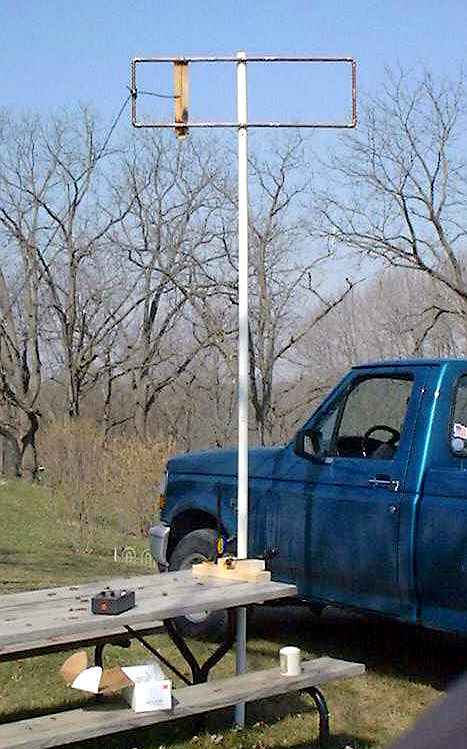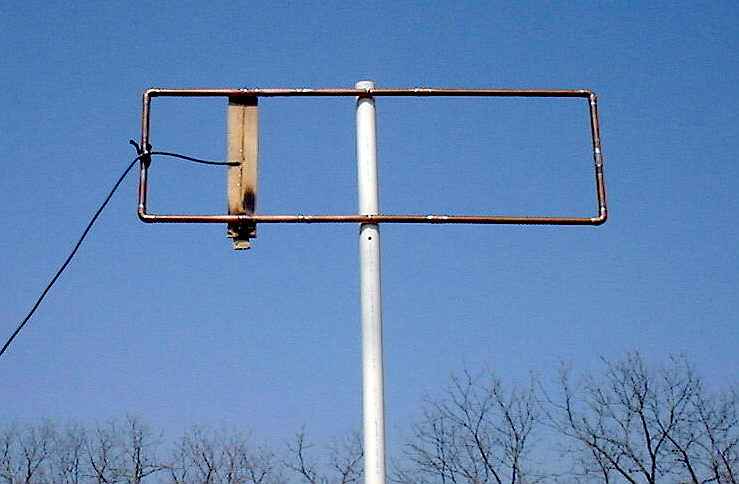|
|
2 Meter
Hentenna "I thought I'd drop a note about my experiences with
the Hentenna. Still using 1/2" copper pipe. I decreased the overall width slightly, saw a favorable result, reduced it a little more and achieved 1.4 swr at 147 Mhz, so I quit there. I wound up with 39.25" long, 12.25" wide, and the #12 bare wire (on a board) feed point is at 8.75", no balun. Dean Straw (Simple & Fun Antennas) modeled it to help out and found nearly identical dimensions using the 1/2" copper pipe in the model. I'm happy with 1.4:1, the feed point resistance is 68 ohms and it's pretty broad: 1.4:1 from 146.3 to 148.2, and the 2:1 bandwidth is 144.6 - 150.6! Don't try to measure SWR on a picnic table! What would Hams do without duct tape? A little time passes and we continue...... I just returned from the final qth. We installed it temporarily until we can purchase better quality coax. The antenna wound up being 15' at the base, on a pvc pipe temporarily duct taped to a 10' 4x4 doing double duty as dipole anchors. The swr at 147Mhz dropped to 1.2 to 1 at that height. and the bandwidth is astounding! I'll make some more measurments when we get it permantly installed.and send you some more info, and probably write a club newsletter article detailing the thing. Dean Straw, N6BV sent some ideas for copper pipe construction in an email, however I had already experimentally found dimensions that were nearly identical and had built the thing out of pipe. This has been a lot of fun, I agree Ham radio needs some easy to build, easy to install, cheap, and good performing 2 Meter antennas. This seems to be one of them. I'll keep ya posted." Terry, WAØITP NOW LET'S BUILD ONE Building the Hentenna I used 1/2 inch copper water pipe as the loop element. Each elbow adds about 3/4 inch to the overall lengths so plan accordingly. I cut the long sides to 37 3/4 inches, and the short sides to 10 3/4 inches. Assemble the loop using 4 elbows and solder. I just laid it out on the garage floor to keep it flat. Use SAFETY GOGGLES or glasses since a concrete floor may “pop off” small pieces of concrete when heated by the torch. I used acid flux and non lead solder from the hardware store but rosin flux should be used for longevity. The feed points were made by glueing a piece of #12 wire from a piece of Romex house wiring to a piece of 1/4 inch plywood. It was moved up and down the loop until a match was found at 147 MHz., then soldered. Plastic clamps (wire ties) were used to hold the wire to the loop while checking swr. Use them in final installation to tie coax to the loop and the support pipe. It is performing well at the final qth and WA0MWW is pleased to be able to use two or 3 repeaters that were unuseable on a 5/8 wave vertical. See pictures below!   Drawing not to scale!  Isn't it a beautiful piece of art! Photography by WA0ITP Go direct to his page for more details on the Hentenna. Learn more about building, testing and putting it on the air! Click here I hope this helps you build this great little antenna. WA0ITP.....TERRY Editors note: From the first email to the working model of this project, Terry only took a couple of days to get the 2 Meter version up and running. After a little fine tuning....now a great project! If you use wood as the support for the feed wires, seal it well with weather proof sealer or use plexiglass or some other suitable non-conductor. Seal all coax end connections from the weather.. Many thanks go out to Terry for sharing his project with all of us! Great work Terry! Keep EXPERIMENTING and have FUN!........N4UJW Incredible online Envision Web Hosting helps you pass in examsheets toefl sample test exam. We offer best quality braindumps - ccda - certification and testking - gmat sample questions - certification for your success in testinside - ccna voice - certification.
  Hamuniverse.com uses Green Geeks Web Hosting! |